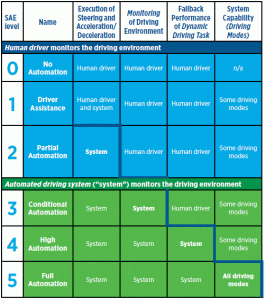The replacement of a human being driving a vehicle for a computational system and adequate tools that allow an autonomous driving is not an idea of this century. A small History context allows one to understand the path since the beginning.
The pioneer event for the AV took place in 1939. The AV was presented at the New York World Fair as a projection of a dream. Norman Geddes, sponsored by General Motors, placed the AV as the vehicle that the world would drive in 20 years28. However, the following years had all efforts on the development of war technology by the biggest car manufacturers.
Only in 1977, Tsukuba University in Japan, built, what it may be considered as the first intelligent robotic vehicle29. With cameras and a motherboard it allowed to detect obstacles and follow lines.
In 1983, Carnegie Mellon University, in the USA, developed a model, the Terregator30, that used a combination of lasers, radars and cameras to move without human interaction. Three years later, the NavLab31, also manufactured by this university, would have been the first AV to carry people aboard at a maximum speed of 32 km/h.
On the same decade (1980), in Europe, the Bundeswehr München university team developed several projects around the autonomous driving. As a result, in 1994, the team presented a modified S-Class Mercedes-Benz called VaMP, that moved autonomously for more than 1000 km, at a speed of 130 km/h28.
ARGO project32, developed between 1997 and 2001, by Parma university, built a prototype (with image interpretation algorithms) that followed lines painted on a road along 2000 km in six days, with an average speed of 90 km/h with 94% of the time completely autonomous29.
In 2004, DARPA, American defense agency, promoted a challenge to accelerate the development of AV. The participants would have to present a AV that could finish the track created by DARPA. None of the participants finished the challenge that year. The year after, 195 teams participated, Stanford university won and 5 teams finished the challenge: more than 200 km in Nevada without a driver33. This was a turning point.
The dream is old, but the effort duplicated in the last few years and the investment in R&D for this topic lost limits or barriers. The automotive industry has been pressured by other sectors to develop technology to make this real, specially IT companies that are interested in playing a role in this market.

